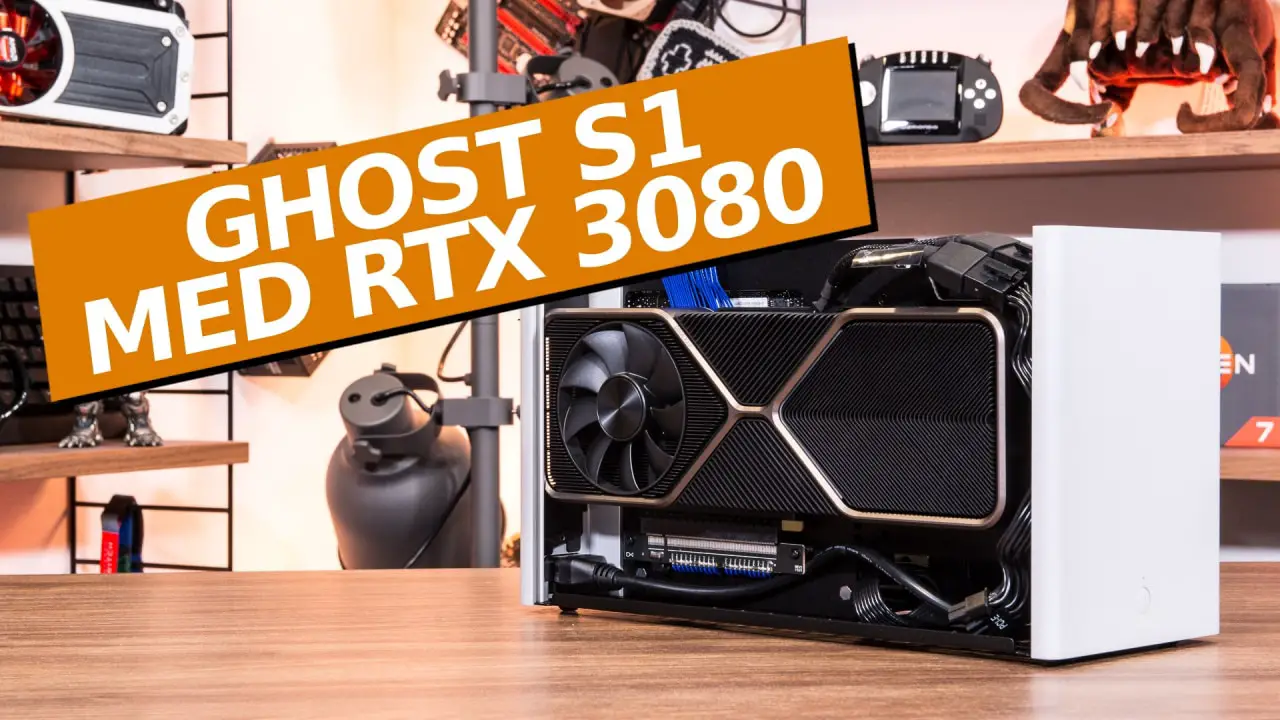When it comes to small computer boxes according to the SFF (Small Form Factor) concept, there are many limitations when it comes to computer components, where size often poses problems. The majority of the graphics cards in the performance class usually take up more than two expansion slots and are thus often too large for SFF builds, but where Nvidia’s and AMD’s own cards often stay within the limits. Then the question is how the cooling will be with the new Geforce RTX 3080 Founders Edition and its different cooling solution.
To investigate this, the editors received a Louqe Ghost S1 MK3 from Inet, where the undersigned immediately started to squeeze components into the chassis. The processor that ended up in the construction is Intel Core i9-9900K which is cooled by Noctua NH-L12 with only the 92 millimeter fan. There is also the Silverstone SX700-LPT at 700 W. Finally, the Geforce RTX 2080 Ti is thrown in for comparison and the EVGA Geforce GTX 1080 Superclocked, which is one of the few third-party cards the editors currently have that can fit in the construction.
To squeeze the cards, the same software is used as in the standard graphics card tests, which then deal with Ungine Superposition, while everything is logged in GPU-Z. The cards are allowed to spin for just over 30 minutes each and the values are picked from the last 60 seconds of each round. Each card was also run twice with a restart in between to be sure that nothing strange happened during the round.
Temperature and fan speed
With the numbers in hand, it does not look as bad as expected where the Geforce RTX 3080 actually ends up one degree below the previous generation top card RTX 2080 Ti. Another surprise was the processor temperature which is higher with the Geforce RTX 2080 Ti which may be due to the radiator whipping around hot air rather than sending it out.
RPM | |
|---|---|
Nvidia Geforce RTX 3080 | 2 325 RPM |
Nvidia Geforce RTX 2080 Ti | 2 450 RPM |
EVGA Geforce GTX 1080 FTW | 2 275 RPM |
With the temperatures reported, it is also worth looking at the fan speed for each card and see if any of the models have it more struggling. That does not seem to be the case, but all ports are relatively close to each other, with the Geforce RTX 3080 in the middle with 2,325 RPM which is fairly calm given the circumstances.
Clock frequency over time
Finally, it’s time to look at the clock frequencies for each card where the Geforce RTX 3080 has it much more swaying than what was seen in the review. The same cannot be said of the Geforce RTX 2080 Ti and EVGA GTX 1080 Superclocked which have significantly smoother clock frequencies.
Geforce RTX 3080 with undervoltage
Not so long ago, @Jonast tried to undervoltage his private Geforce RTX 3080 FE to keep temperatures and noise levels down in his living room computer. The same principle will be used now with the Louqe Ghost S1 chassis with hopes of lowering the temperature a bit further. This means that the voltage is locked to 850 mV at 1,830 MHz.
Temperature and fan speed
With locked voltage and, above all, lower voltage, the temperature for the Geforce RTX 3080 drops by just over four degrees. There are no huge differences but still a step in the right direction as heat and sound level are major factors for small chassis. The processor temperature is unchanged which suggests that the graphics card heat does not have such a big impact there.
RPM | |
|---|---|
Nvidia Geforce RTX 3080 | 2 325 RPM |
Nvidia Geforce RTX 3080 (UV) | 2 120 RPM |
With the Geforce RTX 3080 undervolted, the fans also do not have to spin too much, which of course contributes to a lower noise level, something that is very much appreciated for a building of this size.
Clock frequency over time
With its eyes on the clock frequency, it looks completely different with and completely pasted on 1,800 MHz, which is just over 30 MHz down from the target that was set. A quick look through the log also confirms that the voltage is locked at 850 mV, but also that the clock frequency was up to 1,815 MHz for a short time before the temperatures became too high.
Summary thoughts
Nvidia’s and AMD’s own graphics cards usually take up two expansion slots and thus fit in the Louqe Ghost S1, although the coolers may not always be the most interesting. The latter changed significantly when Nvidia launched the Geforce RTX 3080 with its unique cooler.
With the numbers in hand, the Geforce RTX 3080 manages to handle its own heat in the Ghost S1, even if it still gets hot, you can play with the card. It is worth mentioning, of course, that clock frequencies vary quite sharply when trying to fight against a temperature target. I can really recommend undervolting the Geforce RTX 3080 if it is to sit in a Ghost S1 for slightly lower temperatures and fan speed.
With all that said, Nvidia has stopped selling its own model in Sweden and can only get hold of in the US via Bestbuy, so if you had plans to poke Geforce RTX 3080 into a Ghost S1, it now became much more difficult. The range of third-party Geforce RTX 3080 that fits that particular chassis is also limited, but if you find something, feel free to tip in the accompanying thread or the large Louqe Ghost thread in the forum.
Thanks to Inet who helped us get a Louqe Ghost S1 MK3.















